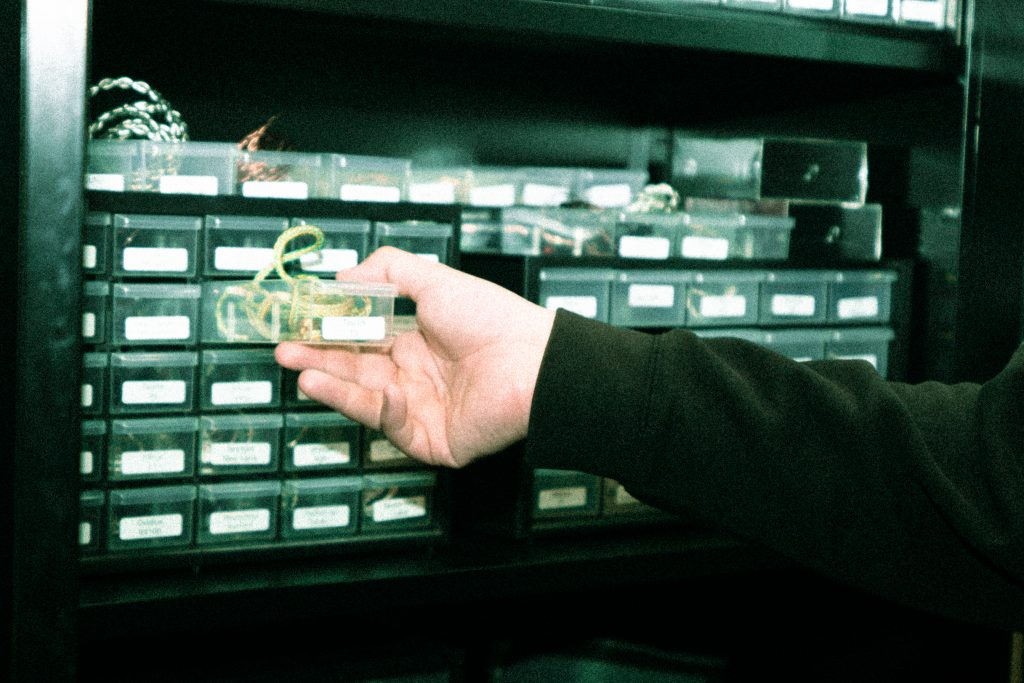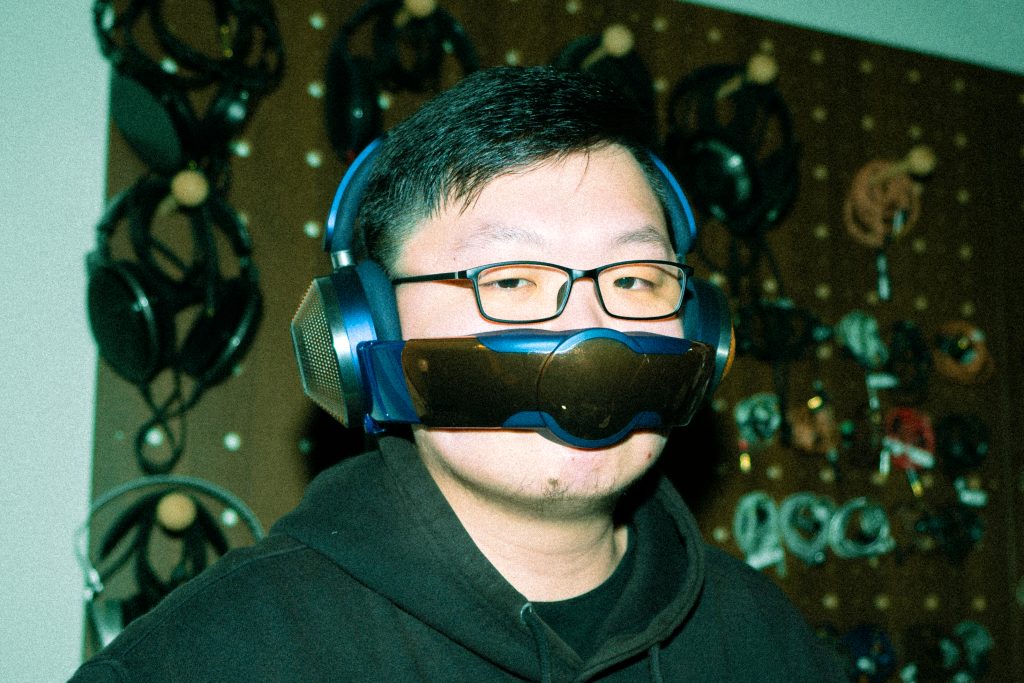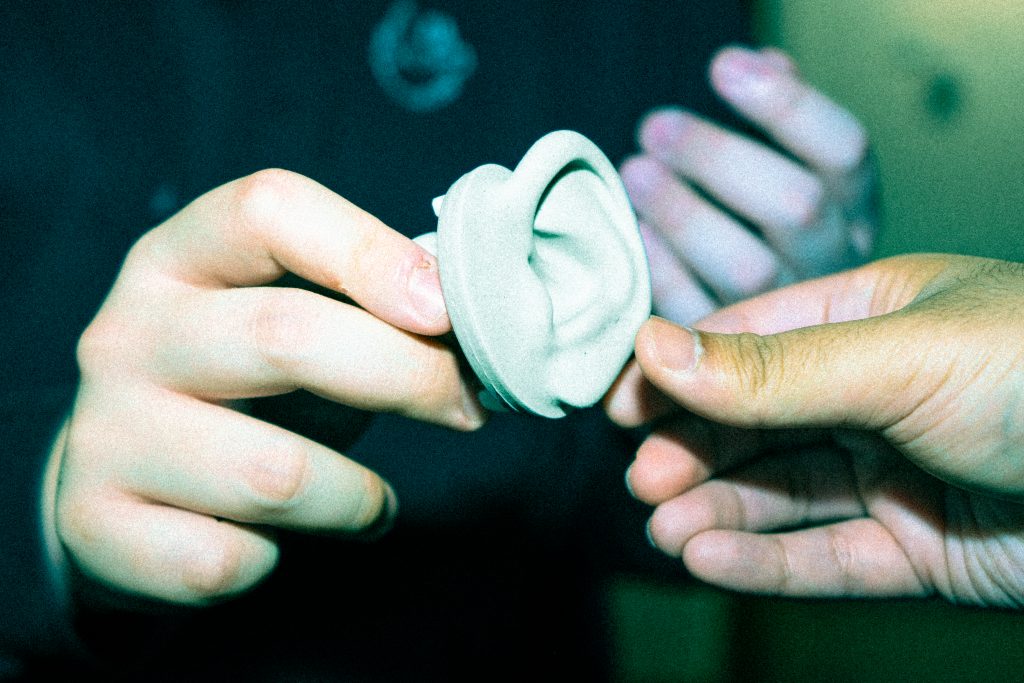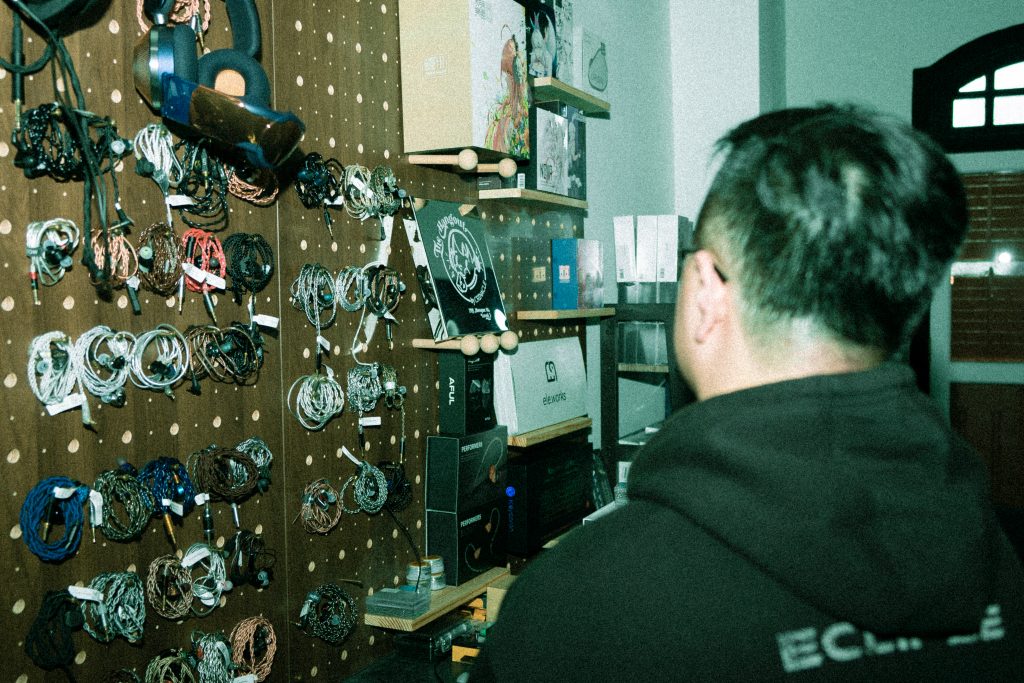All photos by Xue Qi Ow Yeong for RICE Media
Getting a pair of headphones is easy. Getting a pair of headphones you like is tough.
Naturally, it all boils down to personal preference—what you enjoy from a pair of cans or buds can vary greatly. Some crave immersion, as if they’re front row at a concert. Others prioritise intimacy, relishing the remarkable clarity of the little sounds captured in the studio.
Or, maybe you just want to drown your ears in swathes of bass.
If you’ve considered all of this, you’ve likely heard of Crinacle. He may appear on your YouTube front page if you have “AirPods Max review” or “best headphones under $100” in your search history. A content creator he is: alongside his usual reviews are deep-dives into $1,500 earphones and headphones made by, of all companies, Dyson. Yes, they come with an air purifier.
Crinacle is one of the most popular opinion leaders in the global market for headphones and earphones. In-ear monitors (IEMs)—which are designed a little differently from ordinary earbuds—are firmly his wheelhouse.
Counting over 270,000 subscribers, the Singaporean content creator primarily discusses his findings through video reviews. Here, he balances scientific measurements with personal verdicts on new IEMs and headphones—they can be ones on Challenger’s racks or pieces you can only order online.
“[IEMs] have always been an industry within the public consciousness,” Crinacle says. “But the next level up from AirPods has always been, like, kind of obscure.”
Obscure as it may be, Crinacle has been able to make a living out of listening. Now, he’s also in the business of making IEMs of his own.
Listening and Hearing and Listening Again
Crinacle now counts eight unique IEMs under his belt as his products—the result of collaboration with different companies. Some of them are now out of stock, having been sold in limited quantities online.
I meet Crinacle at The Hangout, his shophouse unit along Mosque Street, where these IEMs are on full display next to the counter.
The Hangout serves as a storefront for Crinacle’s products, an office for his small team of employees—two full-timers and a revolving door of part-timers—as well as a provisional studio where Crinacle shoots his YouTube content.
It’s also, of course, a hangout spot where visitors can have a cup of coffee and meet others with similar interests. I’m here on a Tuesday, a day when the shop closes for him and his staff to catch up on administrative work. On some Tuesdays, he writes and shoots his videos there. But not today.
“Honestly, I’ve been racking my brain for ideas,” he tells me.
On display alongside Crinacle’s stock of IEMs and rows of used headphones—his personal collection—are mechanical keyboards offered by Mecha Store.
The Hangout’s visitors comprise a 50-50 split between audio and keyboard hobbyists—they can be secondary school teenagers or working adults. Older visitors above 50 are almost firmly audio enthusiasts, or audiophiles as they’re known.
His viewers know him by the name Crinacle. It’s intentional—he wants you to know him by that name and that name only.
“I just want to be private,” he admits. “I like to keep my personal social media accounts separate from my work.” He also likes to tell people his age is either “19, 29, or 39.”
But what is it? He shakes his head. “I refuse to say,” he chuckles. Fair enough.
The Inner World of In-Ear Monitors
Crinacle’s latest creation is the Moondrop Dusk, a pair of ultra-modern IEMs. Its striking black and silver veneer is supplemented by a carbon fibre faceplate, and its transparent body allows a view into six (!) audio drivers responsible for its audio horsepower.
It looks very impressive, and—according to early reviews—it sounds just as much. The Moondrop Dusk retails for US$359 (S$488), a price tag not to be scoffed at. But in the vast world of IEMs, it’s just a part of the game.

His IEMs vary in price dramatically, from the US$19.99 (S$27) Salnotes Zero to the US$1,399 (S$1,903) Fearless x Crinacle Dawn.
“Right now, the market is in a race to the bottom,” he says. “What used to be audio performance that you could only get at S$500 can now be had at S$50.”
To him, performance isn’t enough: “I’ve heard the best of the best out there. Now, it’s about being impressed by what they can do for the price.”
In some ways, IEMs are made to be niche. When worn, these earbuds are meant to burrow into your ear canals—small to the touch, finicky when used on the go.
With rubber eartips designed to seal your hearing from outside noise, IEMs beg for the right fit in your ears to deliver the sound quality its makers promise. They can be expensive and—save for big brands like Sennheiser, JBL or Sony—only found at more specialised shops or online retailers.
IEMs are also used by professional musicians, who rely on them to concentrate or hear what their fellow band members are playing on stage amidst the overpowering din of a live concert.

The most popular IEMs in the market right now are the wireless AirPods Pro 2, which cost upwards of S$360.
About 16 minutes into his video review (‘AirPods Pro 2: The Audiophile’s Perspective’), which counts over 630,000 views as of writing, Crinacle declares the AirPods Pro to be, well, “pretty good”.
Despite spending 15 minutes on plenty of technical insight, the video, like every review of his, is still rounded off by a succinct verdict: whether Crinacle simply thinks this item is “pretty good” or not.
Every video review by Crinacle comes with a disclaimer, where he links back to a video he published in June 2022 titled ‘Why you SHOULDN’T trust me’.
In it, he goes into detail about the inherent subjectivity that comes with reviewing audio products. He outlines the hazards of being an audio reviewer with a message that, while obviously tongue-in-cheek, is something he feels needs to be hammered home to viewers: “Trust nobody, not even yourself”.
The video’s top comment?
“Crinacle: makes a whole video telling you not to trust him.
Me: I trust this man with my life.”
“Early on, there were fans out there who’d maybe take my words as gospel, even though I tell them constantly not to do so!” he laughs. Discourse is often “circular”, he adds, and “it’s unavoidable.”
He doesn’t say it, but discourse can also make money.
These days, his monetised videos on YouTube also routinely feature ads by hi-fi retailers and websites. Even years back, before the channel and The Hangout, his prolific work caught the eyes of manufacturers and brands, who would send him free units to review.
“The hobby essentially ‘funded’ itself,” he admits.
Crinacle now considers himself “semi-retired” from reviewing IEMs and headphones. The main reason—as he’s covered in recent videos—is that he’s gone deeper into the industry that he used to analyse and, at times, criticise.
First Impression
When asked how he first got into the hobby, Crinacle is unsentimental in his reply.
In his videos, Crinacle is highly articulate, usually droll and snarky. His content—for the most part, released fortnightly—is structured and highly polished, with little room for rants and musings.
Face-to-face, he’s a lot more personable. Soft-spoken but not shy, he’s warm and eager to talk about his work as we dig through his collection of old IEMs. Just not the personal details.

He recalls the products that unlocked the door into this world: a pair of Audio-Technica ATH-M50 he bought in 2009. A year later, he purchased his first pair of IEMs: the Klipsch S4.
Search these products online and you’ll find most of their reviews share a similar sentiment: they’re “bang for your buck”.
“How I got into the rabbit hole was more a case of asking myself: ‘What is the best pair of headphones/IEMs I could buy for the price?’”
Part of what drives people to find opinions by Crinacle, or other content creators, is the tension between price and performance. Is this pair of IEMs really worth that much? Does it sound better than my AirPods? How’s the bass?
“Basically, I realised there weren’t many great answers to that question back then. So I set out to answer it myself (and by extension, answer it for others).”
As the saying goes, pricier doesn’t always mean better. That applies tenfold in an area where breakout products can cost less than, yes, S$50.
Head-Fi—a long-running online portal about all things headphones and IEMs—is where enthusiasts and industry folk converge and, sometimes, butt heads. Crinacle joined it in 2011 after lurking on its pages in anonymity.
In a hobby that involves subjective enjoyment, it’s easy to believe discourse can wind up being toxic.
Crinacle differs. “I think in the grand scheme of things—because I’ve seen many hobbies out there, one of which being keyboards—audio is actually one of the more civilised ones out there,” he states.
Audiophiles go to audio shows, he adds. Putting a face to a forum username can soften the meaner tendencies people may have when they’re behind a screen.

In audiophilia—or the subculture of appreciating high-quality sound—measurements help add a slice of objectivity to a raging discourse of opinions. In 2016, Crinacle started his first forum thread on Head-Fi.
In it, he began publishing his own measurements of earphones—these comprise visual graphs and frequency numbers that evaluate how an IEM performs within the spectrum of human hearing. “I was only one of the two doing it on a large scale,” he recalls. By 2018, he was the only one.
It’s all a bit scientific and inconsequential if you’d rather listen than read—a niche within a niche, to say the least. But the thread won him fans and followers.

Sound Business
Not long after, forum users began sending private messages to him.
They asked for his opinions on certain IEMs and how they compare to others. In 2017, he started another thread, ranking IEMs by numerical scores based on his subjective opinion.
And, of course, subjective opinion in a forum rife with subjective opinions might get you face-down in the mud.
What one person considers to be “good sound” can be thrown out the window by the other. “If you say something bad about certain products, then people would, you know, get up in arms about it,” he says.
“Even brands would come in and be like, ‘Why are you saying this on a public forum?’”
Like most content creators, he found solace in Patreon, where his measurements were accessible to paying subscribers. That also became an issue.
Even if he didn’t see it the same way, the forum began regarding him as “a member of the industry,” he recalls.
They had a point. No longer was he a regular consumer searching for opinions and news. Crinacle was now an opinion leader with content that drew money for him.
In 2019, crinacle.com, or In-Ear Fidelity, was born. If people saw him as an industry player—a Brand©—it was time he owned it.

“The move to the website was ultimately a sound decision,” he maintains. “That was where I could have free rein to just say whatever I want.”
A year later, he graduated with a degree in accounting. Instead of looking for a job, he ended up doubling down on his hobby: “I went into Crinacle full-time assuming that I couldn’t secure a job in that environment anyway.”
He kickstarted his YouTube channel the following year.
Two Ears, Many Hats
Crinacle, The Reviewer, has tried (and perhaps failed) to get viewers to understand that his opinions are simply his own. So Crinacle, The Businessman, is instead working with that dissonance instead of fighting against it.
Simply put, what Crinacle hears is what other people will pay to hear.
Having built his business upon his public-facing brand—its logo an outline of his facial profile—Crinacle covers many aspects of his work. But not the accounting stuff.
“It’s ironic,” he notes. “I’m way out of practice at this point and so I have to hire accountants to do my accounting.”

He’s largely responsible for thinking about what’s next. “I wear many hats,” Crinacle tells me, “but my head’s mostly in the clouds.”
His most prolific collaborator is Moondrop, an audio brand by Chinese company Chengdu Shuiyueyu Technology Co., Ltd. Most people know them as a ‘Chi-fi’ brand.
Over the past decade, the term has been thrown around in hobbyist circles to label the sheer volume of audio products produced by companies in China.
These have earned a league of their own—’Chi-fi’ is largely understood as a product that breaks the price vs performance tension, easing on the former while overperforming on the latter. A reductive term, yes, but a robust one.
For Crinacle, his collaborations have largely remained in the ‘Chi-fi’ realm. “Chinese companies are simply more open to collaboration,” he says. Working with Moondrop and Truthear has been “easy”. He’s had conversations with Western companies, but they weren’t as receptive to the kind of partnership he desired.
It also helps that Moondrop and the like are nearer to Singapore. He’s travelled to Shenzhen several times for meetings with their representatives and to visit their factories. Another trip has been locked in at the end of May.
Crinacle is responsible for “tuning” the IEMs that bear his name—he works out the desired performance numbers and graphs, along with specifications, before sending them to these companies.
They turn these notes into working prototypes, which are sent back to him for testing. After finding the right one, he gives the green light.
He declines to state numbers but mentions over email that “tens of thousands of Crinacle-branded products” are sold every month around the world. His company takes a small royalty cut from each sale.
“For now,” he continues, “we are doing very comfortably”.
However, as a budding businessman, Crinacle wants to eventually strike out for himself. That will include producing his first original IEM. He hopes to get that out into the market within the next year or so.

What about his YouTube channel? He plans to be more intentional with his content, hoping to share more insights as an industry player as opposed to a reviewer. Not that he’s had a choice these days.
Before we end our conversation, I ask him about the reception of the Moondrop Dusk. His latest product has become a point of contention amongst audiophiles—not so much whether it sounds “good”, but whether it’s done “right”. He’s still adjusting to being on the receiving end of criticism.
But rest assured, he’s listening.






